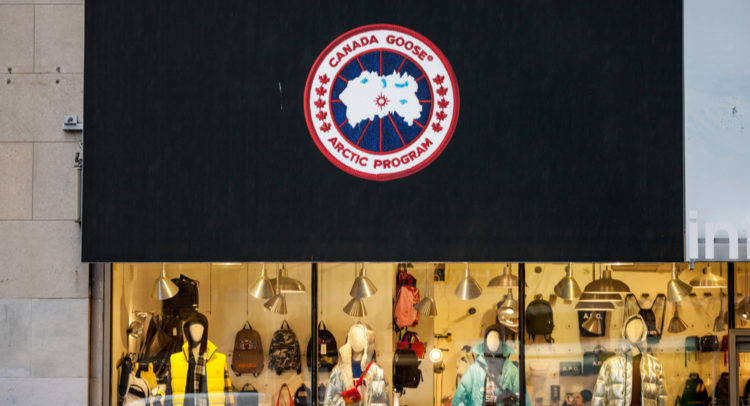Canada Goose Holdings Inc. (GOOS) has been on rocky ground since releasing its Q1 earnings on August 11.
The company is in the midst of a significant shift in retail strategy, as more focus is being placed on direct online sales and its own Canada Goose stores, phasing out third-party retail partners. Canada Goose is a leading global lifestyle brand focused on providing luxury three-season apparel.
Given the significant decline in stock price after Canada Goose’s Q1 earnings release, I am bullish on the stock as current prices provide an interesting entry point. (See Canada Goose stock charts on TipRanks)
With the new strategy comes a shift in revenue seasonality, as the company used to collect wholesale orders early in the year from retailers. While direct sales give GOOS more control over the customer relationship, revenue patterns are being shifted to the end of the year, leaving investors with a show-me story.
Analysts spent much time on the Q1 conference call trying to gain an understanding of the new revenue patterns and sales strategy in order to rejig their financial models.
Management maintained its full-year guidance for the current fiscal year, however, the market did not reciprocate its confidence. Shares were sold off aggressively.
The market does not like uncertainty, and management was unable to calm the market’s jitters regarding a transformational shift in strategy, even though the company has been posting very strong direct sales.
Direct Sales
Global e-commerce revenue increased over 80% in the quarter, driven by the Asia-Pacific/Europe, Middle East, and Africa regions growing in the low triple digits. Revenue from Canada and the U.S. grew 70% and 40%, respectively.
Nearly 70% of Canada Goose sales will come from direct sales in the current fiscal year, up from 52% in Fiscal Year 2019.
That “fundamentally changes the revenue pattern of the business,” with a “huge skew” to the second half, said CFO Jonathan Sinclair. Ultimately, investors are concerned that sales they would’ve seen this quarter have been pushed into the second half of the year and are unwilling to give the company the benefit of the doubt.
Luxury-goods makers are increasingly trying to move towards owning their own retail channels, where they can sell at full retail price and better manage the customer relationship. This helps better communicate the brand and form a lasting relationship with the customer while improving margins over time.
Many brands have witnessed the benefit of a strong online presence during COVID-19 shutdowns, as online retailers flourished. The global pandemic has also accelerated an omnichannel approach, towards which many retailers are slowly working.
The future of retail will continue to evolve as brands are more interested in a direct relationship with customers through an omnichannel approach while utilizing social media as a communication tool.
Sustainability
GOOS is also in the process of a corporate-wide initiative to become a more sustainable company. On June 24, the company announced that it will end the purchase of fur by the end of 2021 and cease manufacturing with fur by the end of 2022.
“We continue to expand – across geographies and climates – launching new categories and products designed with intention, purpose, and functionality,” said Canada Goose president and CEO Dani Reiss. “At the same time, we are accelerating the sustainable evolution of our designs.”
Earlier this year, Canada Goose launched its most sustainable parka to date, the Standard Expedition Parka, followed by the introduction of a new category of lightweight down jackets.
“This is only the beginning of a sustainable apparel journey and the consumer response has matched our own excitement as the style [the Standard Expedition Parka] has nearly sold out,” said Reiss.
The Standard Parka generates 30% less carbon and requires 65% less water during production compared to the in-line Expedition Parka.
In 2019, Canada Goose announced its commitment to achieving net-zero carbon emissions and reducing emissions by more than 80% from current levels by 2025. Other initiatives include plans to transition 90% of its materials to sustainable alternatives and to integrate sustainable solutions into all of its packaging by 2025.
Canada Goose has been heavily criticized in the past by animal rights activists for its use of coyote fur and goose feathers. Becoming a more sustainable company may garner the attention of ESG funds and make the company a target for a new investor group.
Bottom line
Canada Goose is in the early innings of its long-run growth projections. The company is a global, luxury lifestyle brand with a cult-like following. With strong brand awareness in core markets (Canada, Northeast U.S.), and positioned for growth in new regions (Europe, Asia-Pacific), the company must continue to execute according to its growth plans to satisfy market expectations.
The transition to a direct model has created some uncertainty and panic in the stock, which could provide an interesting entry point for long-term investors.
What Analysts are Saying about GOOS Stock
From Wall Street analysts, GOOS earns a Moderate Buy consensus rating, based on 6 Buy ratings and 4 Hold ratings. Additionally, the average GOOS price target of C$62.93 puts the upside potential at 37.7%.

Disclosure: On the date of publication, Sean Tascatan had no positions in any of the companies discussed in this article.
Disclaimer: The information contained herein is for informational purposes only. Nothing in this article should be taken as a solicitation to purchase or sell securities.
















